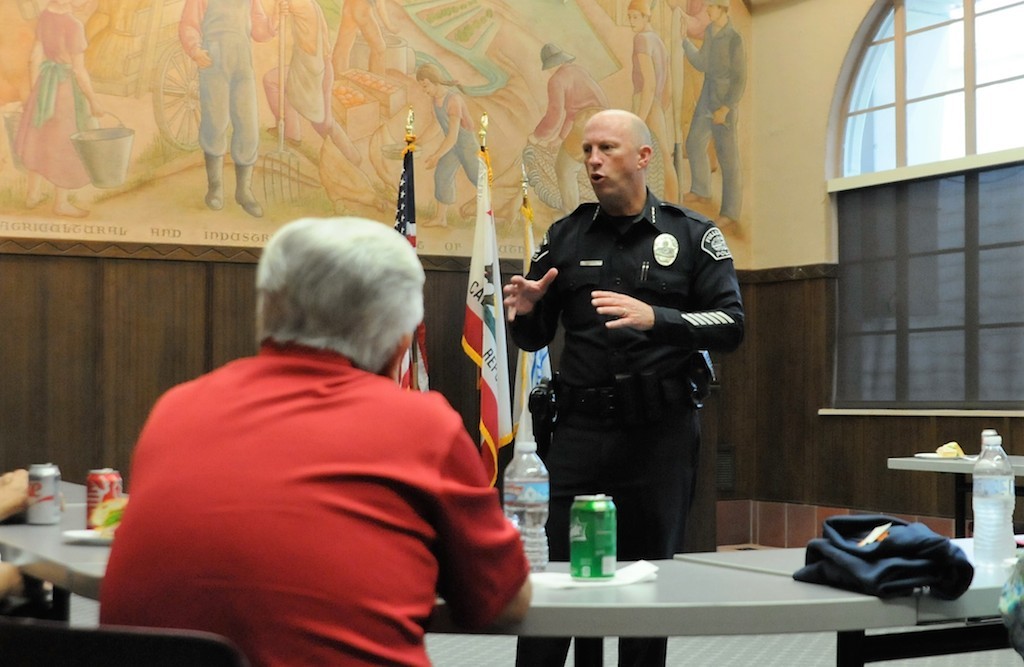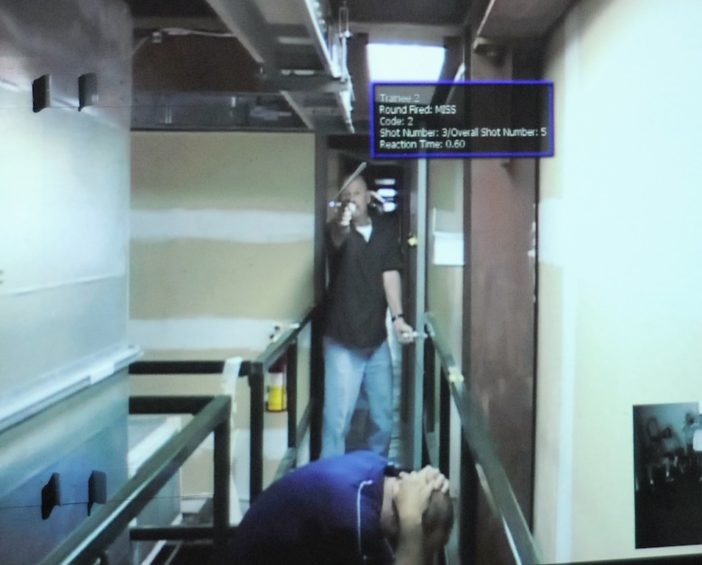Ok, so you’re a police officer.
You’re on patrol when a call comes in from dispatch telling you to respond to a disturbance at a dentist’s office.
That’s all the information you have.
You enter the office and as you approach the reception desk, you see a man arguing with the receptionist in a loud, angry tone.
He’s holding a rifle at his side.

Speaking to members of his Chief’s Advisory Board, Fullerton Police Chief Dan Hughes explains the split-second decisions police officers face when deciding whether to use force. Photo by Lou Ponsi for Behind the Badge
He looks towards you with the rifle still at his side.
Do you shoot?
Do you tell him to drop the weapon?
What do you do?
The members of the Chief’s Advisory Board, formed by Fullerton Police Chief Dan Hughes, were confronted with this and other scenarios on the department’s realistic, interactive training equipment called the Prism Range Simulator.

A screen shot from the highly realistic Prism Range Simulator at the Fullerton Police Department shows an angry man holding a rifle at his side. Responding officers must decide what level of force to use, if any, when confronted with this scenario. Members of the Police Chief’s Advisory Board tried out the equipment recently.
The subjects in the video will react to the officer (you) based on what split-second decision you make.
Make the wrong decision, and you could shoot an innocent bystander.
Hesitate, and you could be shot yourself.
The chief’s advisory board consists of a cross-section of residents representing different factions of the community. They typically meet monthly and discuss issues with Hughes that include crime trends, policies and procedures.
Hughes had the members try their hand on the simulator because he wanted them to experience situations and decisions that police officers face on a regular basis.

Fullerton Police Captain John Siko assesses how well members of the Fullerton Police Chief’s Advisory Board performed in staged scenarios of real-life situations in which officers are faced with the decision on whether to use force. Photo by Lou Ponsi
“Put in your mind tonight that you are the police officer and that police officers are getting shot at all over the country,” the chief told the board members prior to the exercise.
A felony car stop, an active shooter in the workplace, a suspicious man walking through a strip mall, a distraught man threatening suicide and holding a gun to his head.
Actions of the responding officers often determine whether these situations will end peacefully or not.
“You’re making your decision based on a small amount of information that can change your life of the person you are contacting forever,” Hughes said. “The reason we do this is because we want the mistakes to happen in this room and not out there.”

David Benedict, range master at the Fullerton Police Department goes over the results of a use of force training drill on the highly realistic Prism Range Simulator at the Fullerton Police Department. Photo by Lou Ponsi
Also, said the chief, if the officer does use force, his justification for doing so will probed in internal affairs investigations and in court, where every nuanced movement by the officer will be scrutinized.
“Cops have to be able to account for every shot they fire,” Hughes said.
Advisory board member Gregory Bock, a teacher at Orangethorpe Elementary School for 32 years, said the active shooter drill was “eye opening.”
“Clearly it shows the decisions police are faced with every night when it comes to deciding to use force,” Bock said.
Annette Magdaleno said the active shooter drills gave her a better idea of the dangers officers face.
“It changes my perspective completely on what you do as police officers every single day,” Magdaleno said.

Greg Bock, a Fullerton school teacher and member of the Chief’s Advisory Board of the Fullerton Police Department got to play the role of a police officer detaining a suspect during a car stop. The exercise was designed to show the public the life and death situations police officers face and whether or not they should use force. Photo by Lou Ponsi
As a member of the advisory board for a year, PTA mom Ilse Miranda has more of an understanding and an appreciation for the Fullerton Police Department.
“I really respect the police and empower them,” Miranda said. “It’s a life-and-death situation and it’s also stressful.”
Members of the Chief’s Advisory Board have total access to the department, Hughes said.
They’ve talked with detectives and gone on ride-alongs. They can do whatever they want in terms of finding out information about the department.
Advisory board members were the first people in the city to provide input on the concept of body cameras, including policies associated with their use.
They don’t set the policy for the police department, Hughes said, but can have an influence on the policy.
“It’s been fascinating,” Bock said. “Our police department is in good hands. I’m impressed with how (Chief Hughes) wants to make our police department a better police department.”

Greg Bock, a Fullerton school teacher and member of the Chief’s Advisory Board of the Fullerton Police Department got to play the role of a police officer detaining a suspect during a car stop. The exercise was designed to show the public the life and death situations police officers face and whether or not they should use force. Photo by Lou Ponsi
 Behind the Badge
Behind the Badge



